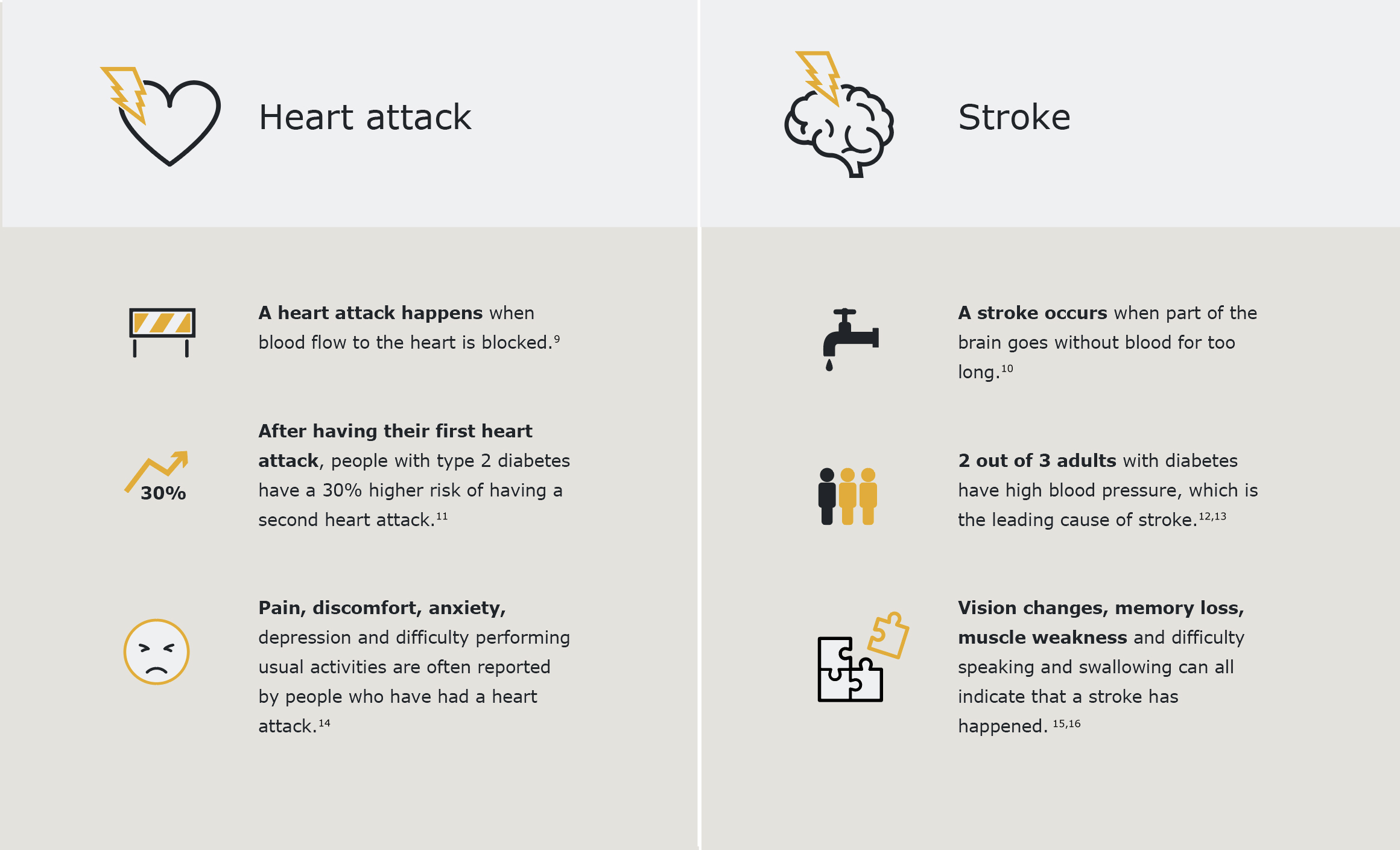
Share This Share ThisEverybody’s got to eat. But if you want to both reduce your risk of developing cardiovascular disease and promote your health living with diabetes, you need to know a few things about diet17.
If you have read this blog post, you will know of the connection between type 2 diabetes and heart disease1. Doctors may not know everything about type 2 diabetes – including how to cure it – but they do know how to treat the symptoms effectively2,3. And that happens to be important in the context of cardiovascular disease4. To find out why, read on.

The more you know about your health, the greater your chance of regulating and promoting it. This is especially important if you are living with a chronic condition such as type 2 diabetes, given its associations with other health issues such as cardiovascular disease4. There is much to keep track of, so without further ado…
Diabetes has to do with metabolism, right? Well, yes. Among those who are diagnosed with type 2 diabetes, many have been living with some metabolic issue for a while5.
The following can all be risk factors for type 2 diabetes:
Scientists and doctors have yet to understand precisely how the individual items on the list relate to each other, but their internal relationships are assumed to have a common basis in metabolism2.
The onset of type 2 diabetes is also, as you would expect, a metabolic phenomenon. Notably, when the condition emerges it doesn’t do so suddenly. Rather, we are commonly talking about a kind of evolution: the increasing or advancing breakdown of insulin’s normal functions7.
This breakdown of insulin’s normal functions – which is a pretty good summary of type 2 diabetes – has something important in common with the aforementioned risk factors: namely the association with increased cardiovascular risk5.
The association is related to high blood sugar levels1. And it is worth taking seriously as it underlies a number of predispositions. For instance, if you have type 2 diabetes, your risk of having a stroke or heart attack is up to 4 times greater compared with someone without type 2 diabetes4,8.
Learn more about high blood sugar and cardiovascular risk in this blog post.
Are heart attack and stroke not really the same thing?
No, they’re not. Here are some of the ways in which they differ:

When considering health statistics such as these, remember this: The information is derived from vast data sets reflecting a wide spectrum of people. The people represent different ages, genotypes, environments and more. Your own personal risk profile can therefore deviate greatly from the mean.
But the take-home message remains the same. By managing your type 2 diabetes symptoms, you are simultaneously promoting your cardiovascular health3.
Everybody’s got to eat. But if you want to both reduce your risk of developing cardiovascular disease and promote your health living with diabetes, you need to know a few things about diet17.
Your goal should be a balanced diet – and we will get to what that means in a second. Try to avoid foods that are high in saturated fat (commonly found in animal products), trans fats (typically found in fried food, cakes and sweet treats)18.
It’s not that fat is simply bad and should be avoided altogether. Rather, studies suggest that if you replace saturated fats and trans fats with unsaturated fats (which are found in avocado, nuts, olive oils and vegetable oils), it can benefit your cardiovascular health19.

Share This Share ThisEverybody’s got to eat. But if you want to both reduce your risk of developing cardiovascular disease and promote your health living with diabetes, you need to know a few things about diet17.
And try to avoid too much alcohol, sugar and salt20.
What’s wrong with salt, you ask? Well, your body naturally seeks to dilute the salt you eat by holding on to water. This extra water increases your blood volume, making your heart work harder simply because it has to push more liquid through your blood vessels. This can lead to hypertension (high blood pressure)21.
Over time, high blood pressure can raise the risk of stroke, heart attack, and heart failure22.
Taken all together, the dietary pointers presented here will help you to better manage your blood sugar, cholesterol, blood pressure and weight – all of which are risk factors of cardiovascular disease.
Suppose you put this list of foods in your pocket next time you went grocery shopping:
A rough shopping guide there, with hopefully something for everyone’s taste!
Final tip concerns your general perspective: Try to see the list not so much as a limitation, but a clarification of what you can safely eat. With that in mind, be explorative. Use the internet! There are countless exciting yet easy-to-master recipes waiting to be discovered!
Maybe you’re already there with this one. If so, good for you! But it needs to be said nonetheless that quitting smoking is one of the most effective things you can do if you hope to benefit your overall health, and especially your cardiovascular health24.
There are many support programmes available to help you stop smoking for good. Talk to your doctor about ways to help you stop smoking.

Share This Share ThisYou don’t need a gym membership or access to a kinesiologist or fitness instructor to begin benefiting from physical activity.
Your body is complicated. Its various functions are interdependent and connected in ways so complex and baffling that scientists are still catching up, trying to learn more.
But the interconnectedness of your body’s various systems comes with an advantage. It means that being physically active and exercising can have a positive effect on more than one element of your overall health.
For example, regularly going for a walk, taking the bike instead of a car when you run errands, or being physically active in other ways can have a positive impact on your:
As you might have guessed it, all of these serve to reduce your likelihood of developing cardiovascular disease25.
Read more about the relationship between high blood sugar and cardiovascular risk here.
You don’t need a gym membership or access to a kinesiologist or fitness instructor to begin benefiting from physical activity.
Why not be a bit pragmatic about it in the beginning and making some pro-physical activity choices? Find little ways to sneak physical activity into your day, say. Here are some examples:
When you get used to taking 10 minutes here and 10 minutes there to be active instead of sitting still, the impact can be considerable over time.
Check out this blog post for advice on how to approach exercise.

Share This Share ThisIf you are like most people living with type 2 diabetes, you can achieve a relationship with your condition that makes life both enjoyable and rewarding.
We’ve been seeing a clear overlap between the following aspects of health4,17:
But lifestyle changes – including a healthy diet, regular exercise and abstinence from smoke and large amounts of alcohol – are unfortunately not always enough.
On top of a health-promoting lifestyle, your personal condition may require medication7. Surely, no one enjoys depending on a very complicated medical regimen. It’s important that you discuss the matter carefully with your doctor to decide which medication can best treat your type 2 diabetes and reduce the risk of cardiovascular events7.
Living well means accepting medical help when necessary
If you are like most people living with type 2 diabetes, you can achieve a relationship with your condition that makes life both enjoyable and rewarding.
It may require developing a new, more pragmatic approach to your health – one characterised by taking regular action to help your metabolism do what it cannot do unaided.
Does your condition currently require medication? Or can your blood sugar be sufficiently well regulated through diet and exercise? Whatever the specifics of your condition, it is a good idea to…
Hopefully, this blog post has served as a good starting point for approaching your doctor (or any healthcare provider). When you do so, try to apportion time to discussing your diabetes requirements as well as your cardiovascular health. Both are important and deserve separate attention, even if one type of medicine can serve as treatment for both.
Talking to your doctor, you might suggest that your blood pressure and cholesterol levels be regularly monitored. Your doctor will be well aware of the advantages of this approach and will help you choose the best treatment.
And print out this quick guide before going to see your doctor – on foot or by bike and preferably by a circuitous route. It will give you an idea of the kinds of questions you may ask to drive the conversation around a few other important matters.
Good luck – and stay safe
And remember: Doctors are just people. They will find it easier to talk to you about your health if you make it clear to them from the start that you are ready to learn more and eager to identify solutions together. And so, hopefully, will you.
HQ24DI00022